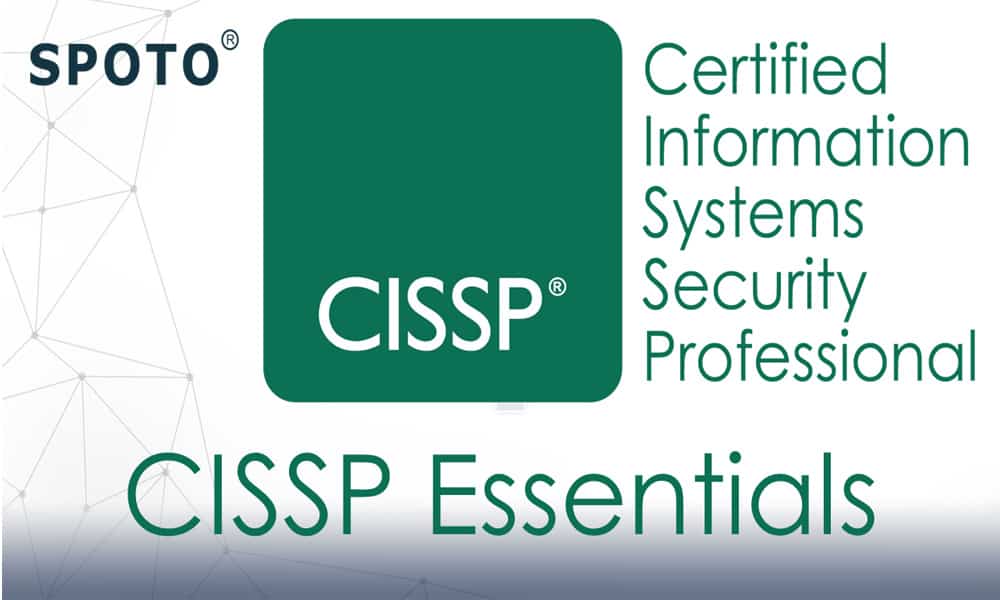
CISSP Boot Camp:
The (ISC) ² Official CBK Training Seminar for the CISSP is the key to achieve success in gaining your certification.
CISSP Course Overview:
This certification is led by an (ISC) ² authorized instructors, this CISSP training seminar is going to provide the candidates a comprehensive review of information security concepts and industry best practices, which would be covering the
8 domains of the CISSP CBK:
- Security and Risk Management
- Asset Security
- Security Architecture and Engineering
- Communications and Network Security
- Identity and Access Management (IAM)
- Security Assessment and Testing
- Security Operations
- Software Development Security
To have proper knowledge of all the above-mentioned CISSP Domains, you are required to have good and proper training, like the
SPOTO. Several types of activities are utilized throughout the course in order to reinforce topics and increase knowledge retention. IT is going to include open-ended questions from the instructor to the students, matching and poll questions group activities, open and closed questions, group discussions, as well as case studies. This interactive learning technique is based on sound mature learning theories.

This training course would be helping the candidates to review and refresh their information security knowledge and help themselves to identify the areas that they are going to need to study for the CISSP exam and features:
- Official (ISC)² courseware
- Taught by an authorized (ISC)² instructor
- Student Guide in electronic format
- Interactive Online Flash Cards
- Post-course CISSP Assessment with 125 questions
- Collaboration with classmates
- Real-world learning activities and scenarios
CISSP Learning Objectives:
- Understanding and applying fundamental concepts and methods related to the fields of information technology and security.
- Aligning overall organizational operational goals with security functions and implementations.
- Understanding how to protect assets of the organization as they go through their lifecycle.
- Understanding the principles, structures, concepts, and standards used to designing, implementing, and monitoring, operating systems, equipment, networks, applications, and those controls utilized to enforce various levels of confidentiality, integrity, and availability.
- Implementing system security through the application of security design principals and the application of appropriate security control mitigations for vulnerabilities present in common information system types and architectures.
- Understanding the importance of cryptography and the security services it can provide in today’s digital and information age.
- Recognizing the impact of elements of physical safety on information system security and applying the secure design principals to evaluate or recommend appropriate physical security protections.
- Understanding the elements that comprise communication and network security coupled with a thorough description of how the communication and network systems function.
- Listing the concepts and architecture that define the associated technology and implementation systems and protocols at Open Systems Interconnection (OSI) model layers 1–7.
- Identifying the standard terms for applying physical and logical access controls to environments related to their security practice.
- Appraising various access control models to meet business security requirements.
- Naming primary methods for designing and validating test and audit strategies that support business requirements.
- Enhancing and optimizing an organization’s operational function and capacity by applying and utilizing appropriate security controls and countermeasures.
- Recognizing risks to an organization are operational endeavors, and assess specific threats, vulnerabilities, and controls.
- Understanding the System Lifecycle (SLC) and the Software Development Lifecycle (SDLC) and also about how to apply security to it, and identifying which security control(s) are going to be appropriate for the environmental development, and assess the effectiveness of software security.
So to gain this course, you are required to join the SPOTO and have their experienced and efficient training of CISSP Certification.


 This training course would be helping the candidates to review and refresh their information security knowledge and help themselves to identify the areas that they are going to need to study for the CISSP exam and features:
This training course would be helping the candidates to review and refresh their information security knowledge and help themselves to identify the areas that they are going to need to study for the CISSP exam and features:
